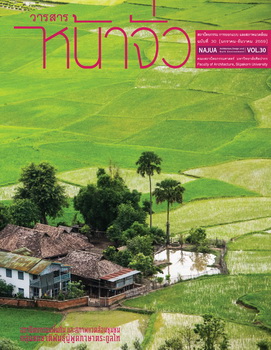บทความแปล “ข้อแนะนำเกี่ยวกับภูมิทัศน์เมืองประวัติศาสตร์”
คำสำคัญ:
ภูมิทัศน์เมืองประวัติศาสตร์, ภูมิทัศน์ย่านประวัติศาสตร์, ยูเนสโก, Historic Urban Landscape, HUL, UNESCOบทคัดย่อ
เอกสาร “ข้อแนะนำเกี่ยวกับภูมิทัศน์เมืองประวัติศาสตร์” แปลจากเอกสาร “UNESCO Recommendation on the Historic Urban Landscape” ที่องค์กรวิทยาศาสตร์และวัฒนธรรมแห่งสหประชาชาติ (United Nations Educational, Scientific and Cultural Organization (UNESCO)) ได้รับรองในการประชุมสามัญประจำปี เมื่อวันที่ 10 พฤศจิกายน พ.ศ.2554 ซึ่งถือเป็นแนวทาง และเครื่องมือการบริหารจัดการว่าด้วย “ภูมิทัศน์เมืองประวัติศาสตร์” ซึ่งมีเป้าหมายเพื่อเป็นเครื่องมือบูรณาการนโยบายเข้ากับการปฏิบัติเพื่อการอนุรักษ์สภาพแวดล้อมสรรค์สร้างโดยมีเป้าหมายที่จะผลักดันให้การพัฒนาเมืองเคารพในคุณค่าของมรดกธรรมชาติและวัฒนธรรมที่อยู่คู่กับภูมิทัศน์เมืองประวัติศาสตร์
โดยที่ประชุมสามัญองค์กรวิทยาศาสตร์และวัฒนรรมแห่งสหประชาชาติ (UNESCO) ได้แนะนำให้ประเทศภาคีสมาชิกนำไปประยุกต์ใช้ในแนวทางที่เหมาะสมกับประเทศของตน กล่าวคือ ประยุกต์ใช้แนวทางของภูมิทัศน์เมืองประวัติศาสตร์เป็นเครื่องมือใหม่สำหรับบริบทที่มีลักษณะเฉพาะ; เผยแพร่แนวทางของภูมิทัศน์เมืองประวัติศาสตร์อย่างกว้างขวางข้ามพรมแดนรัฐชาติ; ส่งเสริมให้มีการนำแนวทางเรื่องภูมิทัศน์เมืองประวัติศาสตร์ไปประยุกต์ใช้ทั้งทางตรง และการประยุกต์สนับสนุนเชิงนโยบาย และมีการตรวจสอบผลกระทบของการอนุรักษ์และการบริหารจัดการเมืองประวัติศาสตร์ สำหรับแนวทางการปฏิบัติต่อไปสำหรับประเทศภาคีสมาชิก และหน่วยงานท้องถิ่นควรนำไปประยุกต์ใช้ต่อ คือ การจัดทำการสำรวจและการทำแผนที่ของเมืองเพื่อแสดงเนื้อหาของทรัพยากรทางธรรมชาติ, ทรัพยากรทางวัฒนธรรม และทรัพยากรมนุษย์; ส่งเสริมให้มีกระบวนการมีส่วนร่วมในการวางแผน และปรึกษากับผู้มีส่วนได้-เสีย สำหรับคุณค่าด้านต่างๆ ที่จะรักษาและส่งผ่านคุณลักษณะไปยังคนรุ่นหลัง; บูรณาการคุณค่ามรดกเมืองและสถานภาพของเมืองเข้าสู่กรอบการพัฒนาเมือง เพื่อออกแบบตัวชี้วัดของพื้นที่เปราะบางสูงต้องการวางผังที่มีลักษณะเฉพาะเจาะจง และรวมไปถึงการออกแบบสถาปัตยกรรม การพัฒนาโครงการในพื้นที่เปราะบางดังกล่าว; จัดลำดับความสำคัญของการอนุรักษ์และการพัฒนาของพื้นที่; สร้างแนวร่วมที่เหมาะสม และกำหนดกรอบของท้องถิ่นในการระบุโครงการอนุรักษ์และพัฒนา ตลอดจนการพัฒนากลไกสำหรับการประสานกับกิจกรรมที่หลากหลายระหว่างผู้ปฏิบัติที่แตกต่าง ทั้งในส่วนภาคราชการ และเอกชน ซึ่งข้อแนะนำดังกล่าวนี้จึงมีประโยชน์อย่างยิ่งต่อแนวคิดในการบริหารจัดการเมืองประวัติศาสตร์ที่ยังมีพลวัตเพื่อนำแนวความคิดไปประยุกต์ใช้ต่อไป
The Recommendation on the Historic Urban Landscape
Kreangkrai Kirdsiri
Department of Architecture, Faculty of Architecture, Silpakorn University
This article is a Thai translation of “UNESCO Recommendation on the Historic Urban Landscape” that was adopted at UNESCO’s General Conference on 10 November 2011. The recommendation is a guideline and tool for dealing with historic urban landscape by means of integrating policies and implementation in order to preserve the built environment. Its purpose is to steer urban development in the direction whereby natural and cultural heritages that form part of the historic urban landscape are accorded the value and respect that they warrant.
The Conference suggested that Member States take appropriate steps to: adapt this new instrument to their specific contexts; disseminate it widely across their national territories; facilitate implementation through formulation and adoption of supporting policies; and to monitor its impact on the conservation and management of historic cities. It further recommended that Member States and relevant local authorities identify within their specific contexts, the critical steps to implement the Historic Urban Landscape approach, which may include the following:to undertake comprehensive surveys and mapping of the city’s natural, cultural and human resources; to reach consensus using participatory planning and stakeholder consultations on what values to protect for transmission to future generations and to determine the attributes that carry these values; to assess vulnerability of these attributes to socio-economic stresses and impacts of climate change; to integrate urban heritage values and their vulnerability status into a wider framework of city development, which shall provide indications of areas of heritage sensitivity that require careful attention to planning, design and implementation of development projects; to prioritize actions for conservation and development; to establish the appropriate partnerships and local management frameworks for each of the identified projects for conservation and development, as well as to develop mechanisms for the coordination of various activities between different actors, both public and private.





